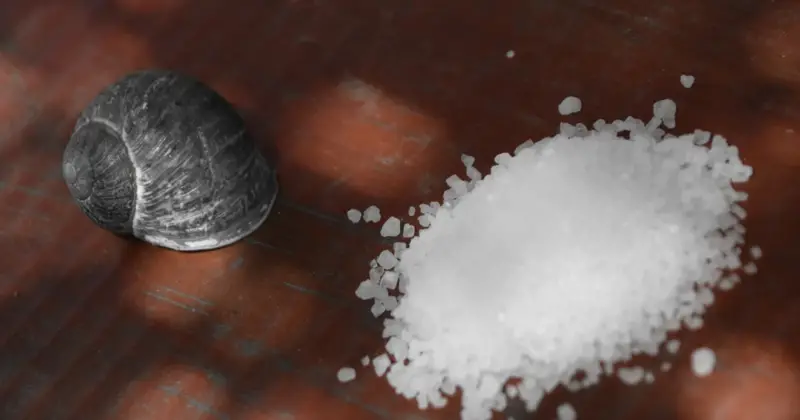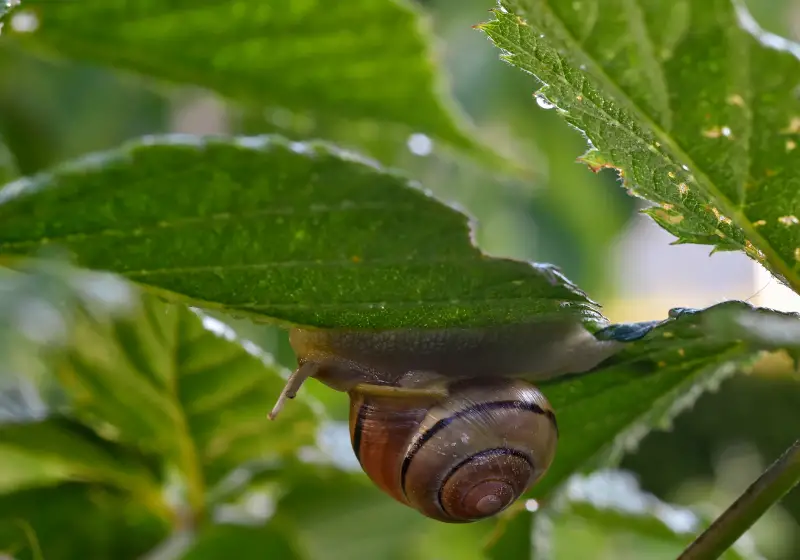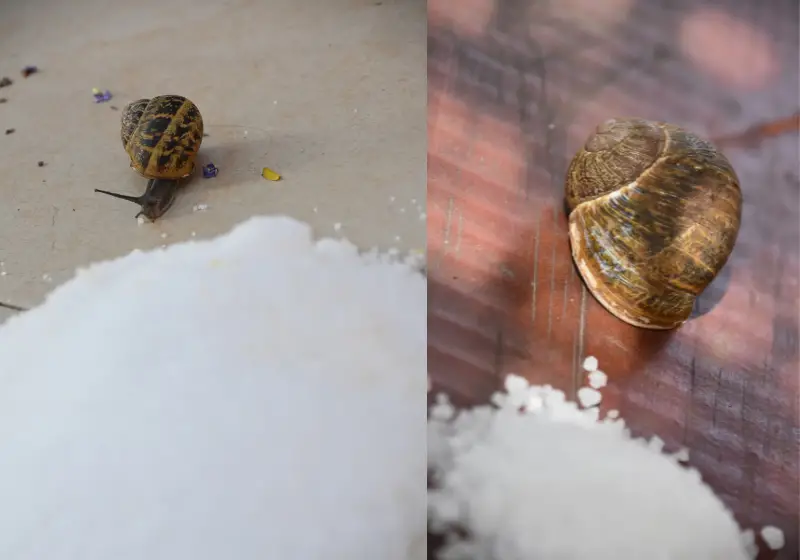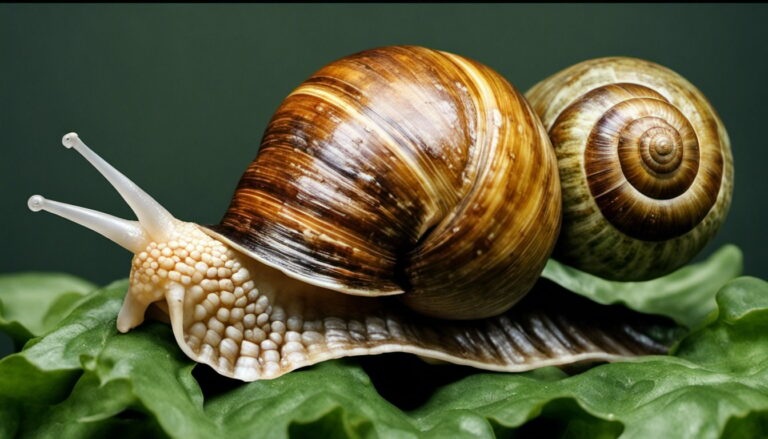Why Do Snails Die from Salt: The Science Explained

Why Do Snails Die from Salt? You might have noticed that snails and slugs tend to meet an untimely end when they come into contact with salt. This occurrence may have piqued your curiosity, leaving you to wonder why salt is so deadly to these small creatures. Understanding the science behind this phenomenon will not only help satisfy your curiosity but also provide insights into the world of these fascinating creatures.

The main reason why salt is harmful to snails and slugs lies in a process called osmosis. Osmosis is the movement of water across a membrane, in this case, the snail’s skin. As snails have highly permeable skin, when salt is poured onto them, it quickly pulls water out of their bodies, leading to rapid dehydration and death if enough salt is present.
Now that you know the key reason behind the unfortunate relationship between salt and snails, you can better appreciate the intricate balance in nature. While it may be tempting to use salt to control these creatures in your garden, more humane methods are available to prevent them from causing damage to your plants.
Contents
Table of Contents
Why Salt Affects Snails

When you sprinkle salt on snails, you might notice them writhing and eventually dying. The primary reason for this reaction is a process called osmosis. To understand how salt affects snails, you should be familiar with their skin composition and the principles of osmosis.
Snails have a permeable membrane, meaning their skin cells allow certain substances to pass through. Their skin also produces a layer of slime, or mucus, which helps them glide smoothly and retain moisture. The presence of salt disrupts the balance between the snail’s internal and external environments.
When salt comes into contact with a snail’s skin, it dissolves in the slime, creating a highly concentrated saline solution. This saline solution draws water from the snail’s body through their permeable membrane, causing rapid dehydration. The snail eventually dies due to the extreme water loss, as their cells can no longer function properly.
The osmosis process, where water moves from an area of lower salt concentration to an area of higher salt concentration, aims to balance the unequal distribution of salt across the snail’s permeable membrane. However, this balancing act is lethal to snails as it forcibly extracts the water necessary for survival.
In conclusion, the interaction between salt and snails results in a fatal osmotic imbalance. When exposed to salt, the snail’s permeable membrane and the slimy mucus layer work against them, as these characteristics encourage rapid water loss and lead to a highly unfavorable outcome.
Physical Reactions to Salt

Dehydration and Snails
When you introduce salt to a snail, it leads to a process called osmosis, which ultimately causes dehydration in the snail. The salt pulls water out of the snail’s body, disturbing the balance between salt and water. As a result, the snail loses moisture, shrivels, and ultimately dies. This is because salt has a strong dehydrating effect, drawing water out of damp materials.
Bubbling Phenomenon
The bubbling you observe when salt comes into contact with snails is due to a chemical reaction between the salt and the snail’s slime. The salt dissolves in the snail slime, creating a saltier solution than inside the snail’s body. This difference in salt concentration leads to osmosis, where water from inside the snail’s body moves out to try and balance the concentrations.
The snail’s body fluids are drawn out during this process, producing a bubbling effect. A hissing sound often accompanies this reaction as the snail’s body rapidly loses water. The combination of dehydration and the bubbling phenomenon contributes to the snail’s death when encountering salt.
Effect of Salt on Snail Shells

When you encounter snails in your garden, you might be tempted to use salt to eliminate them. Salt can effectively eliminate snails, but have you ever wondered how it affects their shells? In this section, we will explore the impact of salt on snail shells and discuss some alternative methods to protect your plants.
Salt exposure can cause the shells of snails to become more brittle over time. This is because the chemical reaction between salt and the calcium carbonate in the snail’s shell weakens its structure. As a result, the shell can become more prone to cracking and breaking when exposed to pressure or stress.
In addition to harming the snail’s shell, salt can significantly affect their ability to absorb nutrients. For instance, calcium is crucial for the proper growth and development of the shell, and the presence of salt can interfere with the snail’s ability to absorb this vital nutrient. This leads to poor shell formation and, in extreme cases, can hinder the snail’s ability to grow and reproduce.
Furthermore, salt can impact adult snails’ and their eggs’ health and well-being. Egg shells are more porous than adult shells, making them more susceptible to the adverse effects of salt. Exposure to salt can cause the eggs to absorb excessive amounts of salt water, leading to dehydration and, ultimately, the death of the unborn snails.
In conclusion, while salt is an effective method to kill snails, it is essential to consider its harmful effects on their shells, ability to absorb nutrients, and overall reproductive health. To protect your plants from snails more humanely and safely, you can try alternative methods such as using copper barriers, diatomaceous earth, or introducing natural predators like birds and frogs into your garden.
Alternative Methods of Snail Control

Use of Bran
Bran is an effective and natural way to control snails in your garden. You can sprinkle it around your plants in a thin layer. When snails come into contact with the bran, they consume it, which interferes with their digestive system, ultimately leading to death. This method is environmentally friendly and safe for your garden’s ecosystem. Remember to reapply the bran after rainfall to maintain its effectiveness.
Snail Traps
Setting up snail traps is another effective and non-toxic method to keep snails away from your garden. There are commercial snail traps available in the market, or you can create DIY traps by using:
- Shallow containers filled with beer or a sugar-water mixture. Snails are attracted to the smell and fall into the traps, where they drown.
- Inverted flower pots or boards are placed near the plants. Snails seek shelter under these during the day, making it easy for you to collect and discard them.
Remember to check and empty the traps regularly to maintain their effectiveness.
Use of Copper
Copper can be a natural deterrent for snails because it produces a mild electrical charge when they come into contact with it. You can use copper in the following ways to protect your garden and house:
- Copper barriers: Place copper tapes, wires, or mesh around your planters, pots, or garden beds to create a barrier that snails won’t cross.
- Copper slug rings are circular copper rings that you can place around individual plants to protect them from snails and slugs.
Ensure the copper materials are wide enough so the snails cannot stretch over them without coming into contact with them. Remember that copper barriers may lose effectiveness if they become dirty or covered with plant debris, so clean them regularly.
Consequences of Salt for Ecosystem

Introducing salt to an ecosystem can significantly affect its components, such as plants, animals, and predators. Understanding salt’s effects will help you understand the importance of maintaining a balanced ecosystem.
One of the primary concerns for plants in salty environments is the absorption of necessary nutrients. Salt can interfere with the plant’s water uptake and essential nutrients, leading to stunted growth or even death. The reduced growth of plants in a salt-contaminated area can affect the entire food chain, as herbivores may struggle to find adequate food sources, influencing the available resources for their predators.
Additionally, some animals may be negatively affected by increased salt exposure. For example, as mentioned earlier, snails die from salt due to osmosis. The excess salt draws water out of their cells, leading to dehydration and death. The loss of snails in an ecosystem disrupts the balance, as these gastropods serve as vital food sources for certain predators like amphibians and birds.
Furthermore, excessive salt can alter the behavior or survival of other aquatic animals, such as fish. High salt concentrations may cause physiological stress and force fish to relocate to areas with lower salinity levels. Such migrations disturb the food chain and change the dynamics of predator-prey relationships in the ecosystem.
In summary, introducing salt into an ecosystem can considerably impact its components. You must know these consequences to preserve a balanced ecosystem and minimize negative effects on plants, animals, and predators.
Snail Species and Salt Sensitivity

Different types of snails have varying sensitivity to salt. Land snails, commonly found in gardens and considered pests, are highly salt-sensitive due to their permeable skin. When you sprinkle salt on a snail, it causes osmosis, pulling water out of their cells, leading to dehydration and death.
On the other hand, aquatic snails have less sensitivity to salt. Some species are freshwater snails and are not adapted to living in saltwater, while others are marine species and naturally thrive in saline environments. If you have pet snails, it’s important to know their salt tolerance before deciding on a suitable habitat.
Common pet snail species include:
- Apple snails: A popular freshwater species, apple snails do not tolerate salt well and should be kept in a freshwater aquarium.
- Mystery snails: Like apple snails, mystery snails are also freshwater snails and should not be exposed to saltwater.
- Nerite snails: These can be found in freshwater and saltwater environments. However, they require brackish water (a mix of fresh and saltwater) for breeding and only lay eggs in saltwater environments.
- Marine snails: Species like the turbo snail and the Nassarius snail naturally live in saltwater and should be kept in marine aquariums.
When dealing with salt sensitivity in snails, it’s crucial to remember that their tolerance can vary depending on the species. If you’re unsure about your pet snail’s needs, it’s best to consult with an expert or conduct thorough research to ensure a safe and comfortable living space for them. Always handle snails carefully and avoid using salt to remove them from your garden to prevent undue harm to the creatures.
Why Is Salt Deadly To Snails?
Preventing Salt Damage to Snails
Creating Humane Solutions
To protect snails from the harmful effects of salt, it’s essential to create humane solutions for your garden or home. Instead of using salt, consider implementing natural methods to deter snails, like providing a rough surface around plants or installing copper tape as a barrier. These non-lethal methods minimize the snail population while maintaining a healthy garden ecosystem.
In addition, ensure that the plants in your garden are receiving adequate nutrients and moisture. Keeping your plants healthy will make you less likely to attract snails searching for decaying organic matter. This approach allows you to maintain a balanced garden environment where plants and snails can coexist without causing any harm.
Save a Snail from Salt
If you encounter a snail exposed to salt, act quickly to save it from further damage. Gently pick up the snail using a soft cloth or piece of paper and submerge it in clean, lukewarm water for a few minutes. This will help rinse the salt away and provide the snail with much-needed moisture.
After the salt is washed away, place the snail in a safe, sheltered area away from direct sunlight or predators. The recovery process may take some time, so regularly check on the snail to ensure it’s regaining its strength.
Overall, preventing salt damage to snails is essential for preserving their fragile lives and maintaining ecological balance. By employing humane solutions and knowing how to save a snail from salt exposure, you can actively contribute to protecting these creatures and the environment.
Frequently Asked Questions: Why Do Snails Die from Salt
How does salt affect snails and slugs?
Salt affects snails and slugs by causing water to be drawn out of their bodies through osmosis. This leads to dehydration, which can ultimately be fatal for these creatures. When you sprinkle salt on snails or slugs, it interacts with the slime on their bodies, causing water loss and discomfort as they dry out.
What is the science behind salt-killing snails?
The science behind salt-killing snails and slugs involves osmosis. In this process, water moves across a semi-permeable membrane (such as the snail’s skin) to balance the concentrations of solutes on either side of the membrane. When salt is applied to snails, water rapidly leaves their bodies due to the high concentration of salt ions outside their cells, resulting in dehydration and eventual death.
Is salting snails and slugs considered inhumane?
Using salt to kill snails and slugs can be considered inhumane because it causes intense pain and distress as they dehydrate and die. More humane and environmentally friendly alternatives are available to control snail populations, such as using barriers, traps, or natural predators like birds and beetles.
How long does it take for salt to kill a snail?
The amount of time it takes for salt to kill a snail depends on the quantity of salt and the individual snail’s size and resilience. However, it generally takes only a few minutes for enough salt to cause dehydration and death in these creatures. Death may be hastened by applying more salt, increasing the snail’s suffering.
Can snails survive in salt water?
Most snails cannot survive in saltwater, as they are adapted to live in freshwater or terrestrial environments. Saltwater can harm their cells through osmosis, causing dehydration and eventually death. However, some snail species, such as sea snails, have adapted to marine environments and can thrive in saltwater.
What alternatives are there to using salt for snail control?
Instead of using salt to control snail populations, consider other, more humane and environmentally friendly options. These may include physical barriers (such as copper tape or crushed eggshells), traps (using beer or bait), or encouraging natural predators like birds and beetles to feed on them. You can also handpick snails and relocate them to a safer place away from your garden or home.

![Do Snails Need Water? [Complete Guide]](https://allourcreatures.com/wp-content/uploads/2021/11/do-snails-need-water-768x513.jpg)


![How Big Do Assassin Snails Get? [Full Guide To Healthy Assassin Snails]](https://allourcreatures.com/wp-content/uploads/2021/11/assassin-snails-768x519.jpg)
![Do Assassin Snails Eat Each Other? [Full Guide]](https://allourcreatures.com/wp-content/uploads/2021/11/assassin-snail-768x465.jpg)
